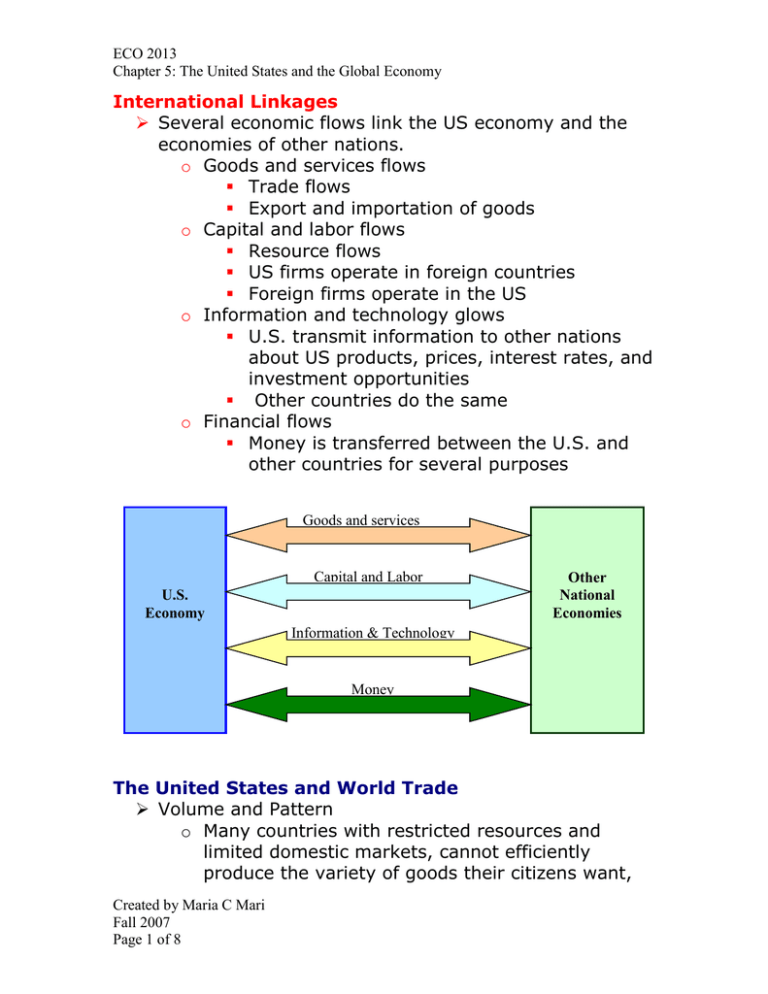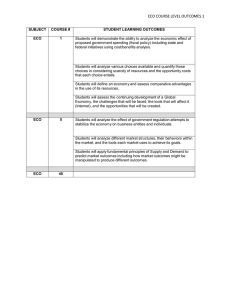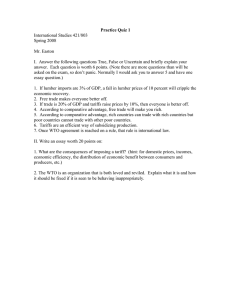International Linkages Several economic flows link the US economy and the
advertisement

ECO 2013 Chapter 5: The United States and the Global Economy International Linkages Several economic flows link the US economy and the economies of other nations. o Goods and services flows Trade flows Export and importation of goods o Capital and labor flows Resource flows US firms operate in foreign countries Foreign firms operate in the US o Information and technology glows U.S. transmit information to other nations about US products, prices, interest rates, and investment opportunities Other countries do the same o Financial flows Money is transferred between the U.S. and other countries for several purposes Goods and services Capital and Labor U.S. Economy Other National Economies Information & Technology Money The United States and World Trade Volume and Pattern o Many countries with restricted resources and limited domestic markets, cannot efficiently produce the variety of goods their citizens want, Created by Maria C Mari Fall 2007 Page 1 of 8 ECO 2013 Chapter 5: The United States and the Global Economy So they must import goods from other nations o Other countries produce more than their citizens want So they must export goods to other nations o US exports 11% of its domestic production and imports about 16%. We are depend on other countries for Bananas Cocoa Coffee Spices Tea Raw silk nickel tin natural rubber diamonds Competition with US produced goods Cars Wine cameras Watches Skis Baseball gloves and balls Exportation Agriculture – 25% of output is exported Chemicals Computers o Trade Patterns Trade deficit Imports > exports Trade surplus Imports < Exports Rapid Trade Growth o Transportation technology o Communications technology Created by Maria C Mari Fall 2007 Page 2 of 8 ECO 2013 Chapter 5: The United States and the Global Economy Comparative Advantage, Specialization, and Exchange o Law of Comparative Advantage: o States that the individual, firm, region, or country with the lowest opportunity cost of producing a particular good should specialize in that good. o Absolute advantage The ability to produce something using fewer resources than other producers use o Comparative advantage The ability to produce something at a lower opportunity cost than other producers face. o Example: o Firms: Apple and Orange produce two products A and B. Apple takes half an hour to produce A and 1/6 of an hour to produce B. Orange takes 1 hr to produce A and 1/12 of an hour to produce B. If the firms only have one hour to produce output of both products. o Firm Product A Product B Apple 1 unit 3 units Orange 1 unit Zero Orange 0 12 units o Apple has the absolute advantage in producing Product A since he only needs ½ hour to Orange’s one hour. o Orange has the absolute advantage in producing Product B since he only needs 1/12 hour to Apple’s 1/6 of an hour. o Apple and Orange can work together to produce more. o If Apple produces only Product A, it can produce two units. Created by Maria C Mari Fall 2007 Page 3 of 8 ECO 2013 Chapter 5: The United States and the Global Economy o If Orange produces only Product B, it can produce 12 units. o Thus increasing total output in the economy. o Why: because Apple has a comparative advantage in producing A and Orange has comparative advantage in B Absolute advantage focuses on who uses the fewest resources, but comparative advantage focuses on what else those resources could have produced, that is on the opportunity cost of those resources. Resources are allocated most efficiently across the country and around the world when production and trade conform to the law of comparative advantage. Foreign Exchange Market Buyers, sellers, whether individuals, firms, or nations, use money to buy products or to pay for the use of resources. International markets: buyers and seller have different currencies Foreign exchange market o A market in which various national currencies are exchanged for one another o Exchange rates are equilibrium prices Created by Maria C Mari Fall 2007 Page 4 of 8 ECO 2013 Chapter 5: The United States and the Global Economy Dollar price of foreign currency rises Equals Equals Foreign currency price of dollar falls Dollar depreciates International value of the dollar falls Equals Equals Internation al value of foreign currency rises Government and Trade Trade impediments and subsidies o Protective tariffs Are excise taxes or duties placed on imported goods. Designed to shield domestic producers from foreign competition Impede free trade by causing a rise in the prices of imported goods and shifting demand toward domestic goods o Import quotas Limits on the quantities or total value of specific items that may be imported o Nontariff barriers Include onerous licensing requirements, unreasonable standards pertaining to product quality, or simply bureaucratic red tape in customs procedures o Export subsidies Created by Maria C Mari Fall 2007 Page 5 of 8 Foreign currency appreciates ECO 2013 Chapter 5: The United States and the Global Economy Consist of government payments to domestic producers of export goods. Enable producers to charge lower prices and thus to sell more exports in world markets. Why government trade invention? o Misunderstanding the gains from trade o Political considerations o Costs to society Multilateral Trade Agreements Trade war – when one nation enacts barriers against imports, the nations whose exports suffer may retaliate with other trade barriers. Reciprocal Trade Agreements Act o 1934 o started the downward trend of tariffs o aimed at reducing tariffs this act had two main features Negotiating authority it authorized the president to negotiate with foreign nations agreements that would reduce existing U.S. tariffs by up to 50%. o Contingent on the actions of other nations Generalized reductions The specific tariff reductions negotiated between the U.S. and any particular nation were generalized through the most-favored-nation clauses. o Stipulates that any subsequently reduced U.S. tariff, resulting from negotiation with any other nation, would apply equally to any nation that signed the original agreement. General Agreement on Tariffs and Trade (GATT) Created by Maria C Mari Fall 2007 Page 6 of 8 ECO 2013 Chapter 5: The United States and the Global Economy o Signed in 1947 between 23 nations. Now 128 o Three principles Equal, nondiscriminatory trade treatment for all member nations The reduction of tariff by multilateral negotiations The elimination of import quotas o Provides a forum for the negotiation of reduced trade barriers on a multilateral basis among nations. o Uruguay Round ( 1995) Tariffs on thousands of products were eliminated or reduced, with overall tariffs dropping by 33% World Trade Organization o Established in 1995 o 149 nations including China o oversees trade agreements reached by the member nations and rules on trade disputes among them o provides forums for further rounds of trade negotiations European Union o Free trade zone called trade blocs o 1958 – Common Market o 2004 – 20 countries o abolished tariffs and import quotas on nearly all products traded among the participating countries o liberalized the movement of capital and labor within the EU o created common policies in other economic matters of joint concern o common currency – Euro North American Free Trade Agreement o NAFTA o US, Canada, and Mexico o Greatly reduced tariffs and other trade barriers Created by Maria C Mari Fall 2007 Page 7 of 8 ECO 2013 Chapter 5: The United States and the Global Economy Globalization The integration of industry, commerce, communication, travel, and culture among the world’s nations Created by Maria C Mari Fall 2007 Page 8 of 8


